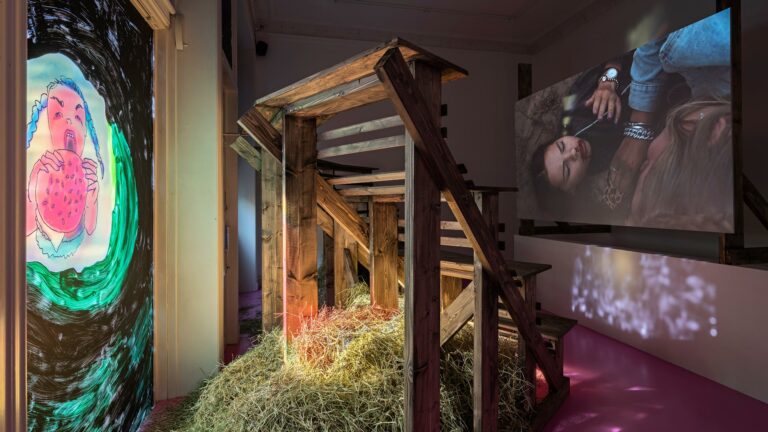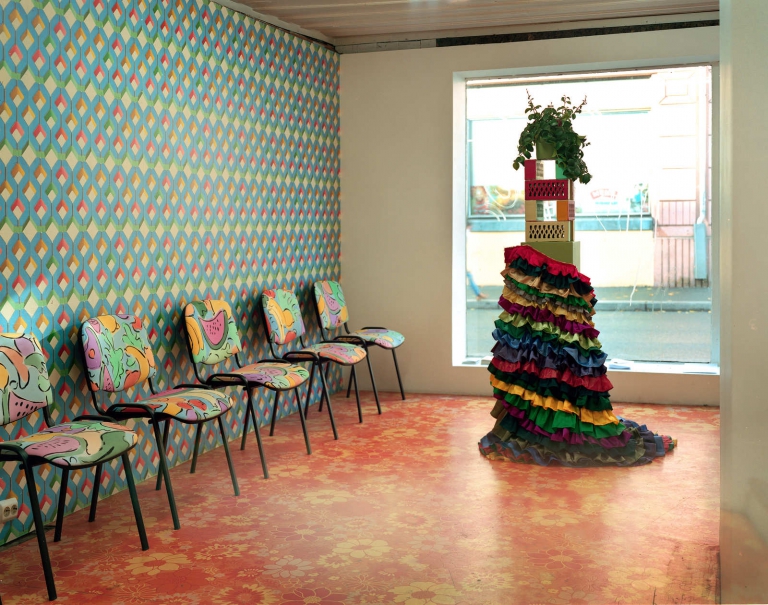Artist: Ragna Bley
Exhibition title: Zooid
Venue: Kunsthall Oslo, Oslo, Norway
Date: March 11 – May 21, 2017
Photography: all images copyright and courtesy of the artist and Kunsthall Oslo
Ragna Bley’s new paintings are over three metres tall, painted on unprimed sailcloth. The sailcloth is bright white, and using it unprimed means that Bley can allow the pigment to diffuse across the fabric, almost like watercolour, creating liquid pools of layered colour that spread through the painting and appear to float in space.
At first sight, the paintings appear abstract, concerned primarily with the play of paint and light on the surface of the canvas. But a second look reveals definite images in the process of formation, blurred figures that have almost, but not quite, defined themselves amongst the swirling clouds of diluted pigment.
At the very beginning of what we now call Modern painting, Édouard Manet was attacked by the critics because his paintings looked ‘unfinished’. Certain key areas—faces, or figures—would be well-defined against a background of improvished brushstrokes that used the minimum of painterly work to suggest form, light and shadow—as though the painting was a brief glance at a scene, registering only the most important details. Bley seems to reverse this sensation; her paintings give the sense that the image has been caught while slowly forming, evolving through the process of painting. The exhibition’s title, Zooid, is a word used in biology for an organism of uncertain status, something that is almost, but not quite, an individual creature; the tiny polyps that come together to make coral reefs are one textbook example.
So Bley’s exhibition is perhaps about this intermediate state, between abstraction and representation, or between thought and expression, and one way to understand her paintings is as being about the potential of the process of painting, or the creative process itself. About a desire to capture a moment in the evolution of the work where the path to its ideal realisation still seems open, before the final closure in which that world of possibility must inevitably vanish.
The paintings are accompanied by many small bronze sculptures. These sculptures take up the theme of Zooid, appearing almost, but not quite, like individual creatures, and echoing some of the shapes seen in the paintings. The walls and floor are both painted white, to suggest that the sculptures and the paintings both inhabit the same environment, and that, like the polyps of a coral reef, they might come together to make a whole.
Ragna Bley (born 1986, Uppsala, lives and works in Oslo) graduated from Oslo National Academy of Art in 2011 and from the Royal College of Art, London in 2015. She has had solo exhibitions at Hester, New York (2015), and Gallery LNM, Oslo (2012), and has taken part in many group shows including the 16th International Painting Triennial, Vilnius (2016), Roaming, UKS, Oslo (2016), Conflicting Évidence, 1857, Oslo (2015) and Young Pioneers, Kunsthall Oslo (2015). Bley took part in Kunsthall Oslo’s summer residency for recent graduates in 2013. She is the recipient of the Hine Painting Prize (2015). Upcoming exhibitions are a solo show at Frankfurt am Main, Berlin in June and The Norwegian Sculpture Biennial 2017 at The Vigeland Museum, Oslo.
Ragna Bley, Slouched cleft, 2017, Acrylic on Dacron, 330 x 170 cm
Ragna Bley, Plastic sluice, 2017, Acrylic on Dacron, 330 x 170 cm
Ragna Bley, Plastic sluice, 2017, Acrylic on Dacron, 330 x 170 cm
Ragna Bley, River custom tepid, 2017, Acrylic on Dacron, 330 x 170 cm
Ragna Bley, Meridian awl, 2017, Acrylic on Dacron, 330 x 160 cm
Ragna Bley, Pit limit, 2017, Acrylic on Dacron, 330 x 170 cm
Ragna Bley, Pit limit, 2017, Acrylic on Dacron, 330 x 170 cm
Ragna Bley, receive in past tense, 2017, Acrylic on Dacron, 330 x 170 cm
Ragna Bley, receive in past tense, 2017, Acrylic on Dacron, 330 x 170 cm
Ragna Bley, Flatter runoff, 2016, Acrylic on Dacron, 310 x 160 cm
Ragna Bley, Flatter runoff, 2016, Acrylic on Dacron, 310 x 160 cm






























